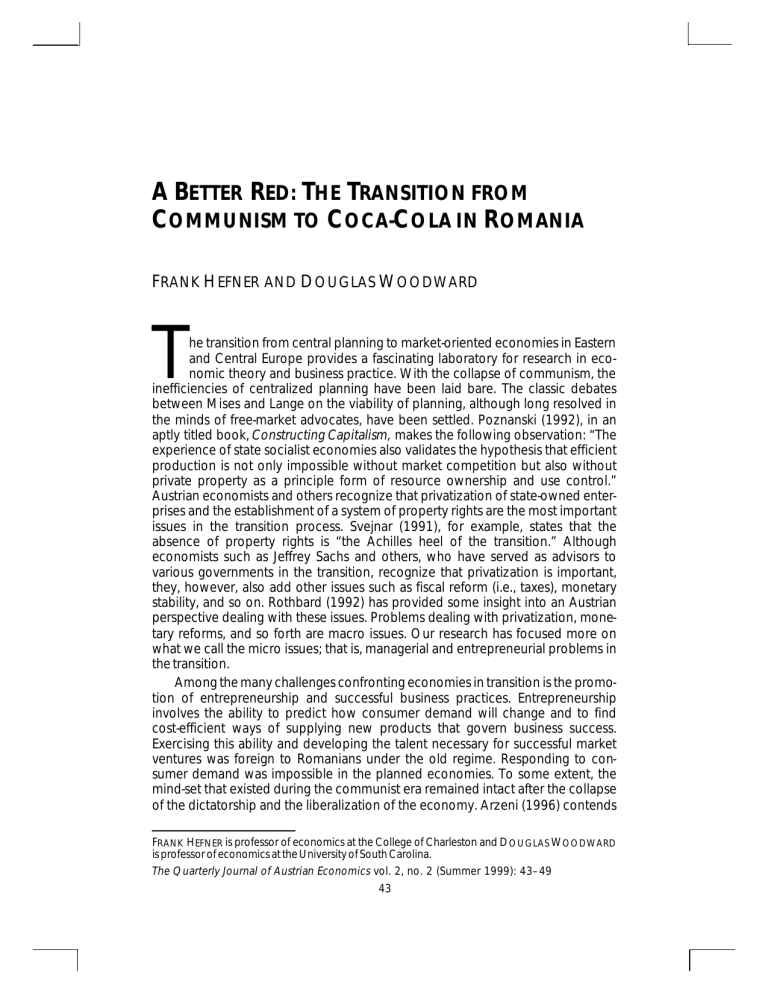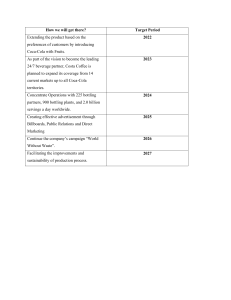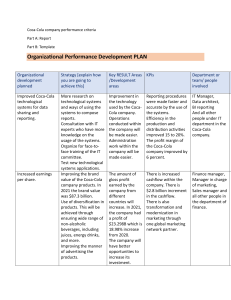
A BETTER RED: THE TRANSITION FROM COMMUNISM TO COCA-COLA IN ROMANIA FRANK HEFNER AND DOUGLAS WOODWARD T he transition from central planning to market-oriented economies in Eastern and Central Europe provides a fascinating laboratory for research in economic theory and business practice. With the collapse of communism, the inefficiencies of centralized planning have been laid bare. The classic debates between Mises and Lange on the viability of planning, although long resolved in the minds of free-market advocates, have been settled. Poznanski (1992), in an aptly titled book, Constructing Capitalism, makes the following observation: “The experience of state socialist economies also validates the hypothesis that efficient production is not only impossible without market competition but also without private property as a principle form of resource ownership and use control.” Austrian economists and others recognize that privatization of state-owned enterprises and the establishment of a system of property rights are the most important issues in the transition process. Svejnar (1991), for example, states that the absence of property rights is “the Achilles heel of the transition.” Although economists such as Jeffrey Sachs and others, who have served as advisors to various governments in the transition, recognize that privatization is important, they, however, also add other issues such as fiscal reform (i.e., taxes), monetary stability, and so on. Rothbard (1992) has provided some insight into an Austrian perspective dealing with these issues. Problems dealing with privatization, monetary reforms, and so forth are macro issues. Our research has focused more on what we call the micro issues; that is, managerial and entrepreneurial problems in the transition. Among the many challenges confronting economies in transition is the promotion of entrepreneurship and successful business practices. Entrepreneurship involves the ability to predict how consumer demand will change and to find cost-efficient ways of supplying new products that govern business success. Exercising this ability and developing the talent necessary for successful market ventures was foreign to Romanians under the old regime. Responding to consumer demand was impossible in the planned economies. To some extent, the mind-set that existed during the communist era remained intact after the collapse of the dictatorship and the liberalization of the economy. Arzeni (1996) contends FRANK HEFNER is professor of economics at the College of Charleston and D OUGLAS WOODWARD is professor of economics at the University of South Carolina. The Quarterly Journal of Austrian Economics vol. 2, no. 2 (Summer 1999): 43–49 43 44 THE QUARTERLY JOURNAL OF AUSTRIAN ECONOMICS VOL. 2, NO. 2 (SUMMER 1999) that the entrepreneurial culture needs to be rediscovered and reinvented. Entrepreneurship is a natural outgrowth of human action. However, the people of Eastern and Central Europe have experienced forty years of rationing, shortages, and other forms of coercion imposed upon them by their governments. How businesses grow and develop out of an economic experience that has been characterized by government distortions is the fascinating transformation taking place in the economies of transition. Although Austrian economists are among the few that recognized the crucial role played by entrepreneurs, Austrian theory is silent on the mechanics of how entrepreneurs get started. To some extent, Austrians can rely on entrepreneurs springing forth spontaneously since profit seeking is a natural and normal action. Once the shackles of oppression have been removed, the entrepreneurial spirit will rise. The innovativeness of entrepreneurship lies in the ability of some new businesses to read the market better than others do—not simply in the short run as arbitrageurs, but in the longer term as fillers of innovative niches. The transition in Romania represents a unique opportunity to investigate the process of developing businesses and entrepreneurship from the remains of one of the most oppressive regimes in Central and Eastern Europe. Our focus here is on the effects foreign direct investment (FDI) has had on the transformation process. FDI represents a desirable form of capital infusion—one seeking profits and exploiting market potential as opposed to a World Bank type loan or subsidies in the form of foreign aid. We were presented with a unique opportunity to investigate the effects of one multinational company (MNC), namely Coca-Cola, on the transformation process in Romania. We conducted interviews and surveys in Romania between July 1994 and January 1995. It seemed appropriate that a consumer product would be influential in the transition from a command to a consumer-led economy. As Austrian theory recognizes, production is only useful when it satisfies the desires of consumers. Foreign direct investment has often been castigated in the past, with expressions such as “Yankee imperialism.” However, it is more appropriate to view FDI as a “white knight.” We found that besides providing capital, FDI provides qualitative impacts in transferring entrepreneurial and managerial skills from well-established profitable firms to developing businesses in transitional economies. AN O VERVIEW OF THE C OCA-COLA S YSTEM IN R OMANIA As background, first consider the transition under way in Romania. In the tumult following the 1989 revolution, the country faced an uncertain and uncharted future. At least since Vlad the Impaler in the fifteenth century, Romania has been considered one of the more tormented parts of Europe. Recent history confirmed this role, for the political and economic difficulties facing Romanians stand out even amid the wreckage of former communist countries. Nowhere was a country so thoroughly exhausted after forty-two years as a “people’s republic.” The terror, megalomania, and cult of personality that characterized Nicolae Ceausescu’s regime since the early 1960s left the country completely unprepared for the transition to capitalism. Ceausescu’s erratic and ultimately disastrous economic policies culminated in a desperate export drive during the 1980s that left the country with little foreign debt, but still woefully inefficient. With minimal exposure to the West through travel or business, Romanians had little foundation or experience with building consumer-oriented businesses within a market framework. A BETTER RED: THE TRANSITION FROM COMMUNISM TO COCA-COLA IN ROMANIA 45 Given the weak market and lack of a well-developed plan for economic reform, Romania posed large risks for foreign investors like Coca-Cola. Transition economies by their nature pose large risks because of the uncertainties of the market reform process. At the time of Coca-Cola’s entrance, Romania had passed a Foreign Investment Law (1991). Coca-Cola received no special incentives to invest, but did receive the benefits already passed in the Foreign Investment Law. This law really did not provide incentives as much as it removed some of the disincentives, such as exemptions from customs duties for imported machinery. Raw materials, consumables, spare parts, and other supplies were exempted from import duties for a period of two years. Foreign firms were exempt from the payment of taxes on profits for a period of five years. At the time of Coca-Cola’s first investment, foreign entities were not allowed to own real estate. Coca-Cola was able to operate in one case by signing a ninety-nine-year concession with the city administration, and in other cases by forming joint ventures with Romanian firms. The access of private companies to foreign exchange was established in 1991. Other than the few tax abatements mentioned, however, Coca-Cola did not receive any kind of governmental incentives. Romania at the time did not impose any wage or price controls for private companies. Coca-Cola did agree to a limited layoff policy for two years in the case of one of its joint ventures. Since the Romanian people (except the ruling elite) had practically no access to Western consumer goods during the Communist era, Coca-Cola had to establish its image as one of the country’s first differentiated, branded consumer goods (as opposed to faceless state products). No doubt, the trademark was already strongly identified with Western capitalism. Under the communist regime, CocaCola, like private consumer goods in general, was portrayed as an icon of Western decadence. To take just one bizarre example from the dark days of the Cold War, Coca-Cola was labelled “the beverage of capitalist sports” according to an official Romanian book on physical education. This was sometimes taken to an extreme, as in the 1959 case of a Romanian fencing champion jailed by authorities after he was caught drinking Coca-Cola in Krakow, Poland. The state forced him to sign a Kafkaesque confession indicating that the soft drink gave him hallucinations and stomach aches. In reality, this had little, if no effect on Coca-Cola’s brand image in Romania. Bombarded with a myriad of propagandistic slogans, while facing a reality showing the contrary, Romanian people now say they gave little credence to the communist regime’s attempts to indoctrinate them about the evils of capitalism, even after forty years. Like most multinational companies, Coca-Cola never seriously considered expanding into Romania before the 1989 revolution. Unlike most Western companies, however, Coca-Cola saw the market potential early in the transition; it started planning to invest soon after Ceausescu’s fall. At the time of the revolution, the soft drink market was dominated by poor quality state brands (B-brands) and Pepsi, operated under an arrangement in which state-owned enterprises were provided concentrate to bottle independently. Using low quality local sugar, water, glass, and other inputs, soft drink products were far inferior at least by Western standards. Predictably, the erstwhile lack of competition had ensured general incompetence. Once the communist regime fell, Coca-Cola executives recognized a “new paradigm in Central and Eastern Europe” at a time when few other Western 46 THE QUARTERLY JOURNAL OF AUSTRIAN ECONOMICS VOL. 2, NO. 2 (SUMMER 1999) companies were willing to invest. The reason is that Coca-Cola is aggressively market-driven; its pursuit of markets has made it the most pervasively branded product in the world. In any event, Coca-Cola was the largest foreign investor in Romania after two years into the transition. Everywhere, its red-and-white logo symbolized the rebirth of capitalism, as it had elsewhere. In newly emerging market economies like Romania, Coca-Cola quickly went from contraband to status symbol. The appearance of Coca-Cola trucks on bleak, riot-torn Bucharest streets was welcomed by citizens weary from years of deprivation and unaccustomed to consumer goods of any consistent availability or quality. Thus, Coca-Cola became a highly conspicuous consumer good in the early period of the Romanian transition—available throughout the country and just as widely accepted. However, it was not an “invisible hand” that brought the product to the people; it took real individual risk and effort to rebuild the exchange system. Nevertheless, throughout Romania’s cities, villages, and towns the “fingers of the invisible hand” (Clower 1994) soon reappeared. Thus, when the old regime collapsed in late 1989, thousands of small shops and street vendors sprang up around the country. The essence of free enterprise, these kiosks and other small-scale retail outlets played a pivotal role during the turbulent first years into the market transition. Under communism, only decrepit state-owned stores were permitted in Romania. There was no Hungarian “goulash” system , the kind that allowed for limited private enterprise along with statism. But when allowed to form, markets appeared almost instantaneously. At first, the re-emergence of retail trade in Romania was dominated by makeshift operations with no focus on what to sell. For many of these nouveaux entrepreneurs, Coca-Cola provided that focus in the early years of transition, especially for the small retail shops and kiosks. In the early 1990s, a large part of the livelihood of these micro businesses came from high turnover products like soft drinks and cigarettes. The profit from these sales then became capital to pay for inventory and for the rest of the operational expenses and for expansion. Romania’s burgeoning retail sector, its new “petite bourgeoisie,” used Coca-Cola as a main source of cash flow. Coca-Cola products served as a magnet for the kiosks, with cases piled outside used as advertising. In an ironic twist, the grey facade of communism was literally covered with Coca-Cola’s red-and-white signs within twenty-four months of Ceausescu’s downfall. Conditioned by the shortages that existed in the previous regime, the regular availability of consumer products was considered somewhat miraculous by Romanians. The small retailers and traders found that simply providing an indication that they stocked Coca-Cola products drew customers to their shops. For many Romanian entrepreneurs, Coca-Cola provided the direct link to modern business practices. T HE IMPACT OF C OCA-C OLA ON R OMANIAN BUSINESS As the familiar Coca-Cola logo spread throughout Romania, it signified the renaissance of the Romanian market economy. By 1994, tens of thousands of businesses were distributing and selling Coca-Cola products. Many other businesses supplied inputs for soft-drink production. These linkages created and supported employment as the state sector shrank. What are the effects of investment by a market-driven multinational company on local business in a transition to markets? Besides its visible impact on re-establishing A BETTER RED: THE TRANSITION FROM COMMUNISM TO COCA-COLA IN ROMANIA 47 retail trade in the country, Coca-Cola’s investment affected many other areas of commerce. Given Coca-Cola’s status as an early entrant in the market economy, it served as the vanguard of the private sector in many areas. One significant transformation in the Romanian business sector propelled by Coca-Cola occurred in advertising. According to some business leaders, the modern advertising industry began in Romania with Coca-Cola’s entrance. Known worldwide for sophisticated, high-quality, and highly successful advertising techniques, Coca-Cola brought these techniques to Romania, insisting on comparable quality being provided by Romanian advertising firms. If it was not available locally, it was imported from other firms. Coca-Cola’s superior quality commercials quickly set the standard of excellence for the country, winning national competitions and putting considerable pressure on other manufacturers and advertising companies to upgrade their efforts. The same effects occurred with outdoor and radio advertising. Another competitive effect of the company’s investment was an upgrading of product quality. Coca-Cola’s insistence on quality spread through its linkages with other sectors of the economy. It would be hard to overstate the importance of introducing quality into a transitional economy. Coca-Cola had a policy of localizing as much of the inputs as possible in order to reduce costs. Yet, it also had a policy of strict quality control. The two policies often clashed in transitional economies. The state-owned industries were not accustomed to delivering quality goods for the internal Romanian market, and the central planning system of the previous regime paid little attention to quality. As a result, the notion of customer satisfaction or product quality were foreign to state-owned enterprises. Even newly-formed or privatized businesses found these concepts to be alien to their mode of thinking. As one U.S. manager stated, “How do you communicate the importance of one-hundred percent quality to people who have been accustomed to standing in line and buying whatever is available at whatever quality?” (Fogel 1995). This manager found that retooling factories is easier than retooling attitudes. While it was common for businesses in developed market-oriented economies to switch suppliers if they were not satisfied with product delivery, this notion was foreign to the practices found in Romania at the time. Many of the qualitative effects of Coca-Cola on the host economy can be summarized as technological, managerial, and organizational competencies. Coca-Cola brought experience to Romania. Specifically, Coca-Cola brought distribution expertise and the concept of serving the customer, which was foreign to the state-owned Romanian enterprises. Coca-Cola provided the first example of a corporate culture in Romania. For example, the manager of a private printing company with Coca-Cola label contracts found that FDI like Coca-Cola’s had already been beneficial for Romania by stimulating efficiency through technology. Whereas a privately-owned company used thirty-six workers to produce seventyfive percent of the orders for Coca-Cola labels during 1994, its state-owned competitor used forty workers to produce twenty-five percent of Coca-Cola’s label business. The state company used the same label machines as the private printer but three times the number of operators. When packing the labels, five times as many workers were used. Although employment declined in the more efficient private label maker, salaries doubled. Rondinelli (1994) noted that in the old regime the socialist leaders pushed state enterprises to create jobs and made it difficult to terminate employment. As a 48 THE QUARTERLY JOURNAL OF AUSTRIAN ECONOMICS VOL. 2, NO. 2 (SUMMER 1999) result, managers had no incentive to use workers efficiently. At the same time, workers were not motivated to be productive: their jobs were secure, their pay was low, and a large portion of their consumption came from state subsidies. The prevailing attitude of workers toward management was reflected in the aphorism: “I’ll pretend to work and you pretend to pay me.” The idea that labor should be a variable input was completely foreign in the old regime. Coca-Cola plant managers reported in interviews that getting the concept across that labor should be a variable input was very difficult. We observed a similar phenomenon in interviews with Polish managers of privatized plants (Hefner and Woodward 1997). In many respects, Coca-Cola set the standards for technological, managerial, and organizational competence throughout the country. As a major MNC in the early transition period, its demonstrative effect was crucial. Other companies, local and foreign, sought Coca-Cola’s trained personnel. Coca-Cola’s presence led to greater competitiveness and product diversity in Romania through a number of avenues. Being a supplier to Coca-Cola put a stamp of approval on a company’s ability to deliver a quality product. Several anecdotal reports confirmed that having Coca-Cola contracts stimulated additional business for some suppliers: the contract enhanced the reputation of the supplier. We surveyed six major suppliers in Romania, all of whom reported that working with Coca-Cola helped them establish other contracts. It was well-known that CocaCola demanded high quality and on-time-delivery. As a result, firms with CocaCola contracts received, in essence, a “stamp of approval” that signalled to other businesses that the supplier could deliver quality, on time. CONCLUSION Private economic activity developed from nothing after 1989 with the fall of Ceausescu (Hunya 1992). Given the extreme isolation of the Romanian economy prior to 1989, it was not altogether surprising that Coca-Cola’s investment had a large demonstration effect. The major effect of Coca-Cola operations on the economy came through the introduction of market-oriented, profit-motivated business practices. In the old economy, suppliers controlled the flow of activity. Bribes were sometimes required to get delivery and, even then, it was erratic. In the new economy, thousands of kiosk owners, the embryonic entrepreneurs of Romania, had the free service of a supplier (Coca-Cola) bringing its product to the point of sale. Regular and free delivery were radical concepts, bringing a permanent and reliable source of cash to the retail and wholesale sector that mushroomed after 1989. In essence, Coca-Cola became a mainstay of small business privatization and entrepreneurship in Romania. There was also significant impact of a symbolic nature resulting from Coca-Cola’s presence in Romania. Rothbard (1992) provided suggestions for successful desocialization. Herbener (1992) discussed the role of entrepreneurs in the process and noted that “Entrepreneurship has no direct role in bringing about the program of desocialization.” However, entrepreneurship and, as we found, foreign direct investment illustrate the benefits of the market economy to a country steeped in planning and government distortions. We found that foreign direct investment can play a major role in the education process needed to retool the attitudes and business practices of Romanians during the transitional process. A BETTER RED: THE TRANSITION FROM COMMUNISM TO COCA-COLA IN ROMANIA 49 REFERENCES Arzeni, Sergio. 1996. “Entrepreneurship in Eastern Europe: A Critical View.” In Horst Brezinski and Micael Fritsch, eds. The Economic Impact of New Firms in Post-Socialist Countries: BottomUp Transformation in Eastern Europe. Cheltenham, U.K.: Edward Elgar. Pp. 52–58. Clower, Robert. 1994. “The Fingers of the Invisible Hand.” Brock University Review 3(1): 3–13. Fogel, Daniel. 1995. “U.S. Machine-Marnt in Poland: Changing a Corporate Culture.” In Daniel Fogel, ed. Firm Behavior in Emerging Market Economies. Brookfield, Vt.: Avebury. Pp. 71–93. Herbener, Jeffrey M. 1992. “The Role of Entrepreneurship in Desocialization.” Review of Austrian Economics 6(1): 79–93. Hefner, Frank, and Douglas Woodward. 1997. “Foreign Direct Investment Linkages and Entrepreneurial Development in Poland: Two Case Studies.” In Arieh Ullman and Alfred Lewis, eds. Privatization and Entrepreneurship: The Managerial Challenge in Central and Eastern Europe. Binghamton, N.Y.: International Business Press. Pp.155–66. Hunya, Gabor. 1992. “Private Economy in an Etatist Environment: The Case of Romania.” In Dynamic Entrepreneurship in Central and Eastern Europe. Derek Abell and Thomas Kollermeier, eds. Amsterdam: EFER-Elsevier. Pp. 107–15. Mazur, Marek, Tomasz Dolegowski, Jerzy Suchnicki, and Igor Mitroczuk. 1994. “Privatization in Poland.” In Rondinelli (1994). Pp. 173–208. Poznanski, Kazimierz. 1992. “Epilogue: Markets and States in the Transformation of Post-Communist Europe.” In idem., Constructing Capitalism. San Francisco: Westview Press. Pp. 199–219. Rondinelli, Dennis. 1994. “Privatization and Economic Reform in Central Europe: Experience of the Early Transition Period.” In idem., Privatization and Economic Reform in Central Europe: The Changing Business Climate. Westport, Conn.: Quorum Books. Pp. 1–40. Rothbard, Murray N. 1992. “How and How Not to Desocialize.” Review of Austrian Economics 6(1): 65–77. Svejnar, Jan. 1991. “Microeconomic Issues in the Transition to Market Economy.” Journal of Economic Perspectives 5(4): 123–38.





